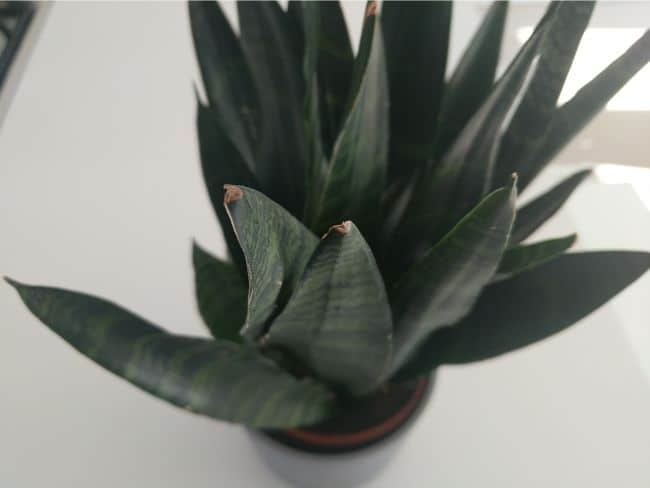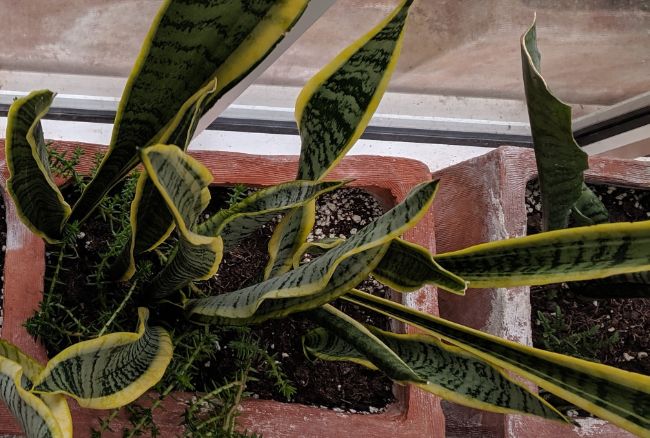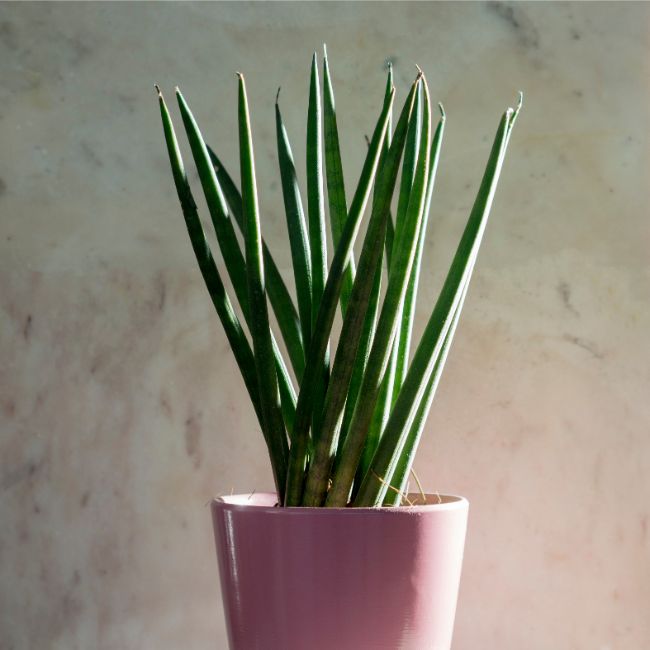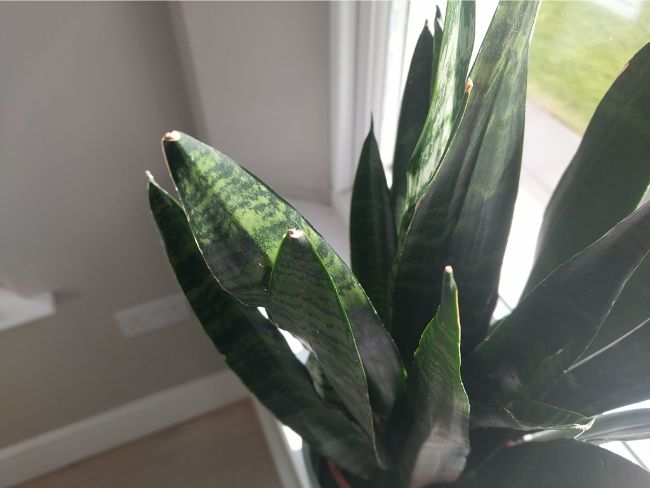Snake plants (Sansevieria trifasciata) have a reputation for being very hardy. That’s probably why they’re a familiar sight in many homes. But even the toughest plants have their limits, and one sign of a problem is brown tips on snake plant leaves.
Why does your snake plant have brown tips on the leaves? Brown tips on a snake plant are most often due to;
- Inconsistent or improper watering
- Over-Chlorinated Water
- Excessive Direct Sunlight And Heat
- Cold Stress
- Excess Fertilizer
- Low humidity
- Pest infestation
These “indestructible” plants are supposed to be so easy to care for, but they won’t thrive or look their best unless you provide the right conditions for them. Read on and I’ll explain how to fix a snake plant with brown tips and how to prevent it from happening.
How Did Your Snake Plant Get Brown Tips?
You’re not supposed to need a green thumb to keep a snake plant healthy. But it is a living thing, and there are limits to the amount of neglect any plant can tolerate.
While snake plants will cope with the stress of imperfect growing conditions, there is a limit. Brown tips on a snake plant is a common response to stress. The trick is to find out what is causing the stress and fix it, before your snake plant sustains too much damage.
If your snake plant is showing other signs of damage, you may like to read my other article about the common reasons why your snake plant might be dying.

1. Watering Problems Causing Brown Tips On Snake Plants
Snake plants only like to be watered once their potting soil has completely dried out. This is probably the most important thing to do to keep your snake plant in good health.
Their health can suffer and the look of the plant will deteriorate when watered incorrectly. The following problems can cause brown leaves and brown leaf tips on your snake plant.
Underwatering
While snake plants are fantastic at conserving and storing water, there is a limit. When the plant gets extremely dehydrated, the first place you will see it is in the leaf tips.
This is a normal response to underwatering, and rarely means your snake plant is going to die. Once regular watering is resumed, the plant will often grow a number of new leaves from the rhizome as it makes use of the new abundance of water.
Inconsistent watering
Most plants acclimatize to their conditions to a certain degree. An underwatered plant that is suddenly subjected to excess water can quickly show signs of stress such as brown leaf tips. This commonly happens whenever I suddenly remember about a plant that I have neglected for a while and try to overcompensate.
It’s always good to have a routine for checking your plants to see if they need watered or have any other problems developing. I normally check in on my snake plants about once per week to see if they need anything.
Overwatering
Overwatering results in the potting media remaining wet most of the time. This reduces aeration of the roots and potting media, allowing anaerobic bacteria and fungi to thrive, which can result in root rot.
Initially, overwatering will result in the plant absorbing too much water, so you will get signs of oedema or even blisters on the leaves. This can result in bacterial or fungal disease in the leaves which will present as brown or black spots on the leaves.
Once the roots are compromised by root rot, the plant will no longer be able to absorb water and nutrients, so you will see signs of nutrient and water deficiency in the leaves, such as discoloration and brown crispy tips on the leaves.
My best advice is to feel the potting media through the drainage holes at the bottom of the pot before watering. If the soil is damp, your snake plant does not need watered.
Watering is one of the most difficult skills to get just right when it comes to houseplant care. I’ve written an article to teach you how to assess when your houseplants need water, so you get this right every time.
2. Over-Chlorinated Water Can Cause Brown Tips On Snake Plants
I’m sure you’re already aware, but there are some houseplants that can be quite sensitive to the type of water that you use when watering them. Most tap water contains chlorine and chloramine, which is very useful for ensuring that our drinking water is safe for human consumption.
However, some plants are more sensitive to these chemicals and can show signs of stress when they are present. Reduce or remove the chlorine by filtering the water you use or leaving the water you intend to water your plant with in sunlight for a day before using it.
3. Excessive Direct Sunlight And Heat
The amount of heat and sunlight a snake plant can tolerate is largely dependent on what they are used to. A snake plant can be grown very successfully in warm conditions, with plenty of direct sunlight, but only if this is what it is used to.
If your plant is used to lower light conditions, it will show signs of stress if it is moved into direct sunlight or warmer conditions. Your snake plant will develop brown tips if it cannot tolerate the intensity of the light.
This doesn’t mean that you can’t move your snake plant once it is used to one location. But try to adjust light and heat levels more gradually so that the plant can acclimatize. This is in much the same way as we acclimatize to hotter conditions over a period of weeks.

4. Cold Stress
Snake plants aren’t cold hardy and you generally shouldn’t expose them to temperatures below 50°F (10°C). Anything below this and the plant can become stressed and you will soon see your snake plant develop brown tips.
For those growing snake plants indoors, it shouldn’t be too difficult to avoid temperatures that low, but if you keep your snake plants outside in the summer, just make sure to bring them in well ahead of the lower temperatures of autumn and winter.
5. Excess Fertilizer Can Cause Brown Tips On Snake Plants
Snake plants are tough succulent plants and have developed the ability to survive in nutrient deficient soils. As a result, their nutrient requirements are low.
If you feed your snake plant too often or use fertilizer that is too strong, you can cause damage to the foliage or roots. This can often cause brown leaf tips, significantly impacting the look of your plant.
I fertilize my snake plants once a month during the growing season. I use this fertilizer and make it up at half strength. Snake plants definitely thrive with a little food, but just be careful not to overdo it.
If you’ve been a little excessive with fertilizing your snake plant, stop for a few months. Flush the potting mix out by running plenty of water through it. This will help to leach the excess nutrients out of the soil. Once your plant looks happy again, you can and should resume feeding it. Just err on the side of too little, rather than too much.
6. Low Humidity
Many indoor spaces are more arid than houseplants like. Dry air causes excess water loss from the leaves and is a really common cause of brown tips on snake plants.
Whilst snake plants don’t need high humidity to thrive, you should aim for humidity levels of at least 40%. I use a digital hygrometer to periodically check the humidity of the air around my houseplants.
7. Pests
Spider plants can be prone to mealy bugs, spider mites and fungus gnats. Of these three, spider mites and mealy bugs can cause brown tips on the leaves of your snake plant. Both these bugs are sap suckers, which can damage the leaves of snake plants causing leaf dehydration.
The dehydration caused by these bugs leads to stress in the plant, resulting in brown leaf tips. Pests are also a common cause of snake plant leaves curling. I’ve written about how to identify and fix snake plant leaf curling in another article.
If your plant has brown tips, it’s always a good idea to inspect the foliage for any sign of pest infestation. Look out for the fine webs of spider mites and the oval bodies or cottony masses of mealybugs.
There are plenty of good ways to get rid of these bugs, and you certainly should do this as soon as possible. It’s also a good idea to quarantine any affected plant, as pest problems are prone to spread.
I generally like to use natural pest control methods first, before resorting to chemical pest control. I’ve written an article about the best natural methods for getting rid of common houseplant bugs.

How To Fix Brown Tips On Snake Plants
The best fix for brown tips on snake plants is to identify the problem and improve the growing conditions to prevent it.
Unfortunately, the damage to existing leaves and the cosmetic impact that this has on your plant is permanent. Even when the plant is given good care, the leaf damage will not resolve.
Don’t worry though, as if you give your snake plant the care it needs, it will grow plenty more healthy leaves and then the impact of the brown tips will be less noticeable.
Alternatively, you could choose to prune the affected leaves.
If the damage is minimal, you may snip off the brown part of the tip. The tip won’t grow back, so make sure you trim your plant in a way that looks good to you. If the damage is severe, chop off the whole leaf at the soil line. The rhizome root structure will send up new shoots soon enough.
Last Word
As you can see, most of the causes of brown tips on snake plants relate very closely to aspects of good snake plant care. If you’d like to learn more about how to get the very best out of your snake plant, read my snake plant care article.
Alternatively, you might like to read the following related articles.

